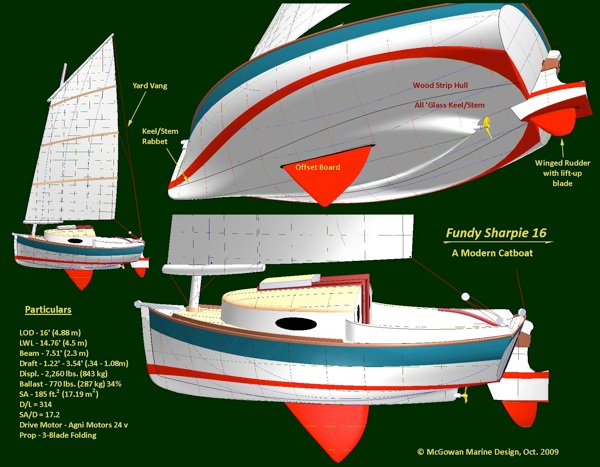
This type of boat - this construction theme - developed from the thought of what a Falmouth Quay Punt hull would look like if a chainsaw were used to cut the keel off parallel with and not too far below the waterline. Sacrilege! Then, with an all-fibreglass keel/stem/lower transom, with shaft tube moulded right into the lower hull, an all-‘glass centreboard case could easily be installed and the rest of the hull constructed using standard wood/epoxy techniques. The worst of modern wood/epoxy construction could be avoided - the hunks of thick (movable) wood that are used in deadwood in many designs, and the leaky centreboard case - leaving room for inside ballast and tanks, engine beds, floors (in larger designs), and thru-hulls that all could get built right into the lower hull.
“But that fibreglass is heavy”, you say. Exactly... right where it’s needed in most designs. And it’s tough stuff: we have decades-old ‘glass fishing boats grounding out twice a day in the huge tides of the Bay of Fundy, and they’re still going strong. The best of ‘glass construction and the best of modern wood construction could be combined for one-offs, series of boats, and especially for good kit boats. Imagine getting your 16-footer (say) in a box, opening it up and setting the ‘glass lower hull on the inverted bulkheads and transom, then starting to strip plank the next day. All that keel, stem and centreboard case setup hassle could be avoided. The 64’ sloop Mischief was planned to be built this way.

This little catboat features a powerful modern lug rig, efficient underbody and offset centreboard, 3 berths, a small head and galley, a 6’ (1.83 m) cockpit, almost 5’ (1.52m) of headroom, and a solar/electric drive setup with folding 3-blade prop. No construction plans as yet, but weight and centre of gravity calculations have been completed, and the numbers look good. You can see the construction details here - especially the keel-to-planking rabbet line. A more refined version, the Fundy Cat 16 was developed from this model.
Copyright 2001-2021 inclusive McGowan Marine Design, Inc.
Fundy Sharpies

